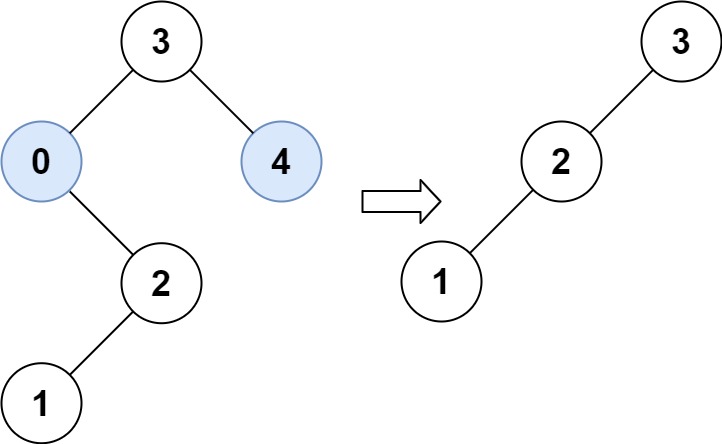Problem
Given the root of a binary search tree and the lowest and highest boundaries as low and high, trim the tree so that all its elements lies in [low, high]. Trimming the tree should not change the relative structure of the elements that will remain in the tree (i.e., any node’s descendant should remain a descendant). It can be proven that there is a unique answer.
Return the root of the trimmed binary search tree. Note that the root may change depending on the given bounds.
Example 1:

1 | Input: root = [1,0,2], low = 1, high = 2 |
Example 2:

1 | Input: root = [3,0,4,null,2,null,null,1], low = 1, high = 3 |
Example 3:
1 | Input: root = [1], low = 1, high = 2 |
Example 4:
1 | Input: root = [1,null,2], low = 1, high = 3 |
Example 5:
1 | Input: root = [1,null,2], low = 2, high = 4 |
Constraints:
- The number of nodes in the tree in the range
[1, 104]. 0 <= Node.val <= 104- The value of each node in the tree is unique.
rootis guaranteed to be a valid binary search tree.0 <= low <= high <= 104
Analysis
题目要求对一颗BST剪枝,剪掉不在题目要求范围内的节点。二叉树的问题一般就是通过递归来求解,我们判断节点的值是否在范围内,如果在范围内,则对其左右子树分别递归即可;如果超过范围,分以下情况:
- 如果小于
low,说明该节点的左子树也要整个剪掉,直接对其右子树递归; - 如果大于
high,说明该节点的右子树要整个剪掉,直接对其左子树递归。
Solution
无
Code
1 | /** |
Summary
这道题目是二叉树类的题目的一个小变种,本质上只是对节点的值做判断,然后剪枝。coding方面还是利用比较常见的递归进行求解。这道题这道题目的分享到这里,谢谢您的支持!

